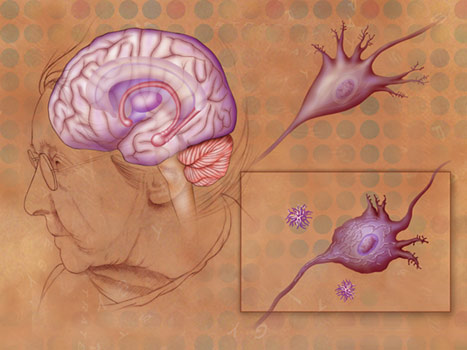



Neurodegenerative diseases are a heterogeneous group of disorders that are characterized by the progressive degeneration of the structure and function of the central nervous system or peripheral nervous system. Common neurodegenerative diseases include Alzheimer’s disease and Parkinson’s disease.

Investigators at Rush University Medical Center and the Brigham and Women’s Hospital in Boston reported the discovery of a new gene that is associated with susceptibility to a common form of brain pathology called Tau that accumulates in several different conditions, including Alzheimer’s disease, certain forms of dementia and Parkinsonian syndromes as well as chronic traumatic encephalopathy that occurs with repeated head injuries.
Our Pharmacodynamics Department can deliver multiple nervous system models based on anti-depressants, anti-Alzheimer's drugs, sedative-hypnotic and anti-anxiety drugs, analgesics, anti-convulsants, anti-Parkinson's drugs, and anti-schizophrenia drugs. Those models can effectively evaluate innovative drugs at the molecular and cellular level, as well as ex vivo, and in vivo. The Department's advanced Cognition Wall Discrimination learning ensures uninterrupted tracking to determine changes in memory function in double transgenic mice during early-stage Alzheimer's disease and eliminates the disadvantages of the Morris water maze (MWM) in stress interference and short-time tests.
The findings from this new study—published recently in Molecular Psychiatry in an article entitled “Susceptibility to Neurofibrillary Tangles: Role of the PTPRD Locus and Limited Pleiotropy with Other Neuropathologies”—describe the identification and validation of a genetic variant within the protein tyrosine phosphatase receptor-type delta (PTPRD) gene, which the authors show has a high association with tauopathies.
“Aging leads to the accumulation of many different pathologies in the brain,” explained co-senior study investigator David Bennett, M.D., professor of neurological sciences and director of the Rush Alzheimer’s Disease Center. “One of the most common forms of pathology is the NFT that was at the center of our study. The NFT is thought to be more closely related to memory decline than other forms of aging-related pathologies, but there are still very few genes that have been implicated in the accumulation of this key feature of Alzheimer’s disease and other brain diseases.”
Since NFT accumulation is thought to be closely linked to cognitive decline in for Alzheimer’s patients, the investigators surmised that there was a genetic commonality among NFT disorders. The researchers performed a genome-wide association study, obtaining autopsy material from 909 individuals and assessed the subjects’ genome for evidence that a genetic variant could affect NFT.
“The variant that we discovered is common—most people have one or two copies of the version of the gene that is linked to accumulating more pathology as you get older,” noted lead study investigator Lori Chibnik, Ph.D., assistant professor of neurology at Brigham and Women’s Hospital. “Interestingly, tangles can accumulate through several different mechanisms, and the variant that we discovered appears to affect more than one of these mechanisms.”
The authors believe that their new findings offer an important lead as the field of neurodegeneration searches for robust novel targets for drug development. This is especially true given the recent disappointing results in Alzheimer’s disease trials targeting amyloid protein, the other major form of pathology related to Alzheimer’s disease. Tau pathology is more closely connected to the loss of brain function with advancing age and may be more impactful as a target. The advent of new techniques to measure Tau in the brains of living individuals with positron emission tomography offers a biomarker for therapies targeting Tau.
“This study is an important first step. However, the result needs further validation, and the mechanism by which the PTPRD gene and the variant that we have discovered contribute to the accumulation of NFT remains elusive,” concluded co-senior study investigator Philip De Jager, M.D., associate professor of neurology at Brigham and Women’s Hospital. “Other studies in mice and flies implicate PTPRD in memory dysfunction and worsening of Tau pathology, suggesting that altering the level of PTPRD activity could be helpful in reducing an individual’s burden of Tau pathology.”
 Relevant
news
Relevant
news